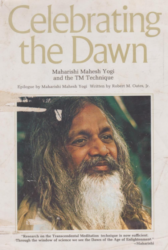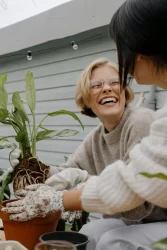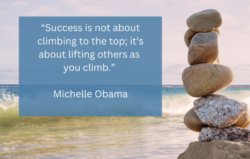Yearning for More: The Quest for Enlightenment, Part One

Most of us have experienced a deep yearning for something more in life—a sense that there is more than the status quo of work, school, relationships and family. We wonder: what is this life about? My search started intensely at the age of 13.
As the daughter of a minister, I shared my father’s commitment to ethical action and altruism. In junior high and high school I did volunteer work for programs of poverty and illiteracy alleviation, working with disadvantaged children. But it was clear that the unhappiness I felt in my own life was affecting my ability to help others. I remember once working with a child who came from a troubled background, and as he cried, I cried too—in empathy, sympathy, and bewildered frustration. I thought: how can I truly help this child and family? I wondered—how can I help myself, full of anxiety and depression? If I myself was suffering and unaware of how to find more fulfillment, how could I help others to live more fully?
And so I began to search for something that would provide meaning and fulfillment. In the early 1970s, there were a lot of choices to investigate. But in my search I had some requirements—not clearly articulated at the time, but held on a gut level. I was looking for something: 1) essential to human nature, relevant to all human beings, that would also honor and nourish one’s particular culture and individuality; 2) something that was deeper than intellectual concepts or even emotions; 3) not fundamentally dependent upon another human being; 4) nourishing to others as it nourished myself—compassionate expression would need to be an outcome; 5) supported by scientific research.
Living in a multicultural area and experiencing the interfaith activities of my parents, I was drawn to find a universal source of human development and spirituality. So I dove into psychology. I approached Freud, but found his views—based upon the study of neurotic human beings—ultimately unsatisfying. And the utopia that behaviorist B.F.Skinner proposed left me cold. In terms of philosophy, I began reading the existentialists. They did not help, although Jean Paul Sartre did a good job of describing the existential ‘nausea’ I was experiencing, in his book by that name!
I was babysitting once in the home of some members of our church. I picked up a pamphlet that was sitting on a side table. I remember that it asked, “Do you feel like a football, kicked around by life?” Somehow I felt some relief just to have the question posed. And my response: oh yes. I felt beaten up by life. Who didn’t, in this world where the newspapers presented, to my raw and openly empathetic young teenager self, gut-wrenching photos of a horrible war, stories of divisiveness everywhere. And where the pressure to succeed had no underlying meaning. And in my relationships with boys…lets just say that the expectations were less than life-supporting in the late 60s and early 70s. All of this, for me, amounted to depression and an overwhelming bafflement about the nature of this life.
And a burning search for something more.
In 11th grade, my public high school opened an alternative school (The Scarsdale Alternative School, still going strong). I took a course called Philosophy Through Literature in which we studied texts from western and eastern traditions. Here, I finally encountered writers/sages who were addressing the questions I was asking: what is the nature of life? What are the possibilities of human development? Why is there suffering, and how do we alleviate it? Is there a possibility for living joyfully? How can we help others?
It was in this course that I began to hear more about a higher state of human development called enlightenment. As I sat with other students in a circle with our young teacher, discussing texts concerning the possibility of a higher state of consciousness, my awareness began to feel a breeze of… freedom. Relief. Some faint breath of joy.
Enlightenment was described as a state of consciousness—not just a temporary glimpse, but an all-time stabilized state of awareness—as different from waking state as waking was from dream or sleep state. A state of unshakeable inner peace, joy, clarity, creativity, energy. A state of natural compassion that did not dissolve into misery in encountering the misery of others, but rather, could uplift others. Unbounded freedom, bliss, wise intelligence, even playfulness.
These descriptions stirred some early childhood memories. Around the age of five, I had had some glimpses of a state of awareness of light-filled, glorious bliss. So I knew this experience was possible.
In the texts we read, we heard of Taoist sages who were anchored in silent joy, flowing calmly through whatever came their way. In this state, one was no longer a football to outer circumstances, or dark inner moods.
I wondered: had I ever encountered people who expressed these characteristics? I had heard of athletes who slipped into a state of lightness and sublime well-being while performing. Or a friend who said he slipped into a state of superfluid awareness while playing his guitar one night. Suddenly, he played with effortless perfection, harmonies flowing out of his hands that he never thought possible.
And doctors able to maintain their cool while performing surgery in disaster areas. Or someone like Victor Frankl, functioning from an inner core of integrity, freedom, compassion, and even joy while in a concentration camp.
In our philosophy class, we read of saints such as Buddha, who blossomed in enlightenment after a path of extremes, discovering the Middle Path, including meditation.
I wanted more of this state of awareness.
A teacher was invited to speak at our high school on Transcendental Meditation. Not much older than we were, she was a warm, authentic, lively and intelligent person who clearly enjoyed talking with us teenagers.
She also offered an academic course called Higher States of Consciousness, and we used a book edited by John White called The Highest State of Consciousness. This book was a compilation of historic and contemporary accounts of enlightenment, and included some of the first research on meditation, which happened to be Transcendental Meditation.
As I began to have some understanding of the highest state of human development, I could see how this would provide some direction for my burning questions: what is the nature of life? Is there more to life than this rigmarole? Is there a way to alleviate suffering, and the sense of being kicked around like a football?
Halfway through this course, our teacher invited us to learn TM. About two thirds of us learned.
During the TM course, I noticed fatigue pouring out and began to feel more rested. My insomnia began to lighten. I felt fresher, more awake. As I walked to and from school, I felt the grandness of the trees, and the song of the birds stirred a faint sense of happiness. After a few weeks I also began to experience something deeper—a very subtle, non-flashy sense of greater inner stability. I remember trying to describe the experience to family and friends: I felt more solid inside. Less vulnerable to negativity in the world, anxiety about school, family difficulties, and negative influences from peers.
In the course of learning TM, our teacher talked about the field of Being at the source of our own individual lives and all of life. It was the silent, hidden source—an invisible, unmanifest field of creative intelligence—of all that we see and experience. Developments in physics were pointing to such a field at the basis of life, supporting this perspective.
I remember my teacher standing at a black board and drawing a tree. She said the tree represented each one of us, with the branches representing different aspects of our lives and interests. The root system was like our nervous system. If the roots of a tree are not nourished, then all aspects of the tree become weak and wither. One might attempt to prop up each branch, or paint the leaves green—which, of course, does not actually strengthen the tree. But if you water the root of the tree, the whole thing flourishes. Likewise, the experience of inner silence, pure Being, nourishes us in a fundamental way, and all aspects of ourselves naturally blossom.
In the follow-up sessions of our TM course, our teacher explained more about the state of Being, which we experience as a 4th major state of consciousness, Transcendental Consciousness. In Maharishi’s words:
Underneath the subtlest layer of all that exists in the relative field is the abstract, absolute field of pure Being, which is unmanifested and transcendental. It is neither matter nor energy. It is pure Being, the state of pure existence….Everything is the expression of this pure existence or absolute Being which is the essential constituent of all relative life.
Maharishi articulated what I had experienced in my own life, without the awareness of Being:
All relative life without the conscious basis of Being is like a ship without a rudder, ever at the mercy of the tossing sea. It is like a dry leaf on the ground left to the mercy of the wind, drifting aimlessly in any direction in which the wind takes it. The life of the individual without the realization of Being is baseless, meaningless and fruitless. Being is the basis of life, that which gives it meaningand makes it fruitful.
We students perked up even more when we heard about a 5th state of consciousness. Through the regular alternation with activity, Transcendental Consciousness would become permanent in a 5th state of consciousness called Cosmic Consciousness. In Maharishi’s words:
Having come back home, the traveler finds peace. The intensity of happiness is beyond the superlative. The bliss of this state eliminates the possibility of any sorry, great or small. Into the bright light of the sun no darkness can penetrate; no sorrow can enter bliss-consciousness, nor can bliss-consciousness know any greater gain than itself. This state of self-sufficiency leaves one steadfast in oneself, fulfilled in eternal contentment.
In the years since I began TM, this has been my experience, unfolding gradually, naturally, innocently. And the growth of inner calm, joy and wisdom spontaneously overflows in compassion, along with greater ability to help others. In the next few blogs, I will explore more the seven states of consciousness that Maharishi has so clearly delineated, giving us a vision of possibilities, as well as practical programs for unfoldment.
Quotes by Maharishi Mahesh Yogi are from his Science of Being and Art of Living and On the Bhagavad-Gita: A New Translation and Commentary
About the Author
Cynthia Johnson is a teacher of the Transcendental Meditation program. She holds a Master of Theological Studies from Harvard Divinity School and is a mother, wife and writer. She is a contributor to the book A Symphony of Silence: An Enlightened Vision (1st and 2nd editions) by George Ellis.





